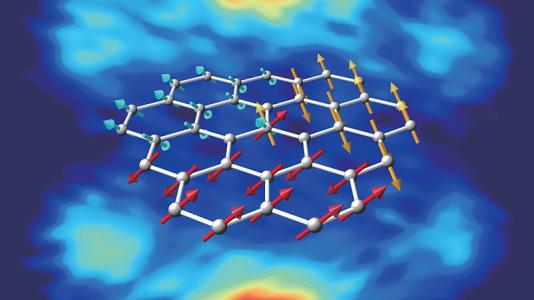
Argonne Materials Science Division (MSD) Researchers Sae Hwan Chun, Hong Zheng, Constantinos C. Stoumpos, Christos D. Malliakas and John F. Mitchell and Advanced Photon Source (APS) X-ray Science Division (XSD) researchers Jong-Woo Kim, Jungho Kim, Yongseong Choi and Thomas Gog, have published a letter in Nature Physics providing direct experimental evidence for dominant bond-directional magnetic interactions in Na2IrO3, the key element needed to realize a new type of quantum spin liquid.
Quantum spin liquids (QSL) are elusive states of matter that arise when magnetic interactions are frustrated so that long-range ordered states favored by conventional magnets do not appear as the ground state. QSL are examples of ‘emergent’ or collective phenomena, and have been implicated as routes to high temperature superconductivity and as platforms for quantum computation. One variety of QSL, a Kitaev spin liquid, has been predicted theoretically to exist on a “honeycomb” lattice. The Kitaev interaction forces spins connected by any given bond to point only along a single one of the principal axes of the structure, but the threefold symmetry of the honeycomb lattice means that this ‘bond-dependent magnetic anisotropy’ is frustrated; all three possible spin directions are equally probable and no long-range order can develop.
A physical realization of this honeycomb lattice is found in in sodium iridate, Na2IrO3, whose underlying electronic state built on Ir4+, satisfies the criteria set out for the Kitaev QSL. Although several different theoretical treatments of Na2IrO3 have suggested that such Kitaev type interactions are important in Na2IrO3, no experimental work has directly shown this to be the case, until now.
The research team used a combination of APS beamlines 6-ID-B,C; 9-ID-B,C; 27-ID-B and 30-ID-B,C to test the hypothesis. Using resonance X-ray magnetic scattering at the APS the team identified diffuse magnetic scattering from a short-range ordered magnetic domain, one of the three predicted by the 120o symmetry to fluctuate into one another.
By systematically rotating the crystal, all three domains were interrogated, showing that the spatial anisotropy is “locked” to the spin-space anisotropy, an existence proof for the Kitaev interaction. Simulations of the diffuse scattering and its angular dependence by collaborators at the Max Planck Institute in Stuttgart furthermore establish that this Kitaev interaction is dominant for describing the magnetism in this honeycomb lattice material.
The Kitaev QSL is not yet realized in Na2IrO3 due to minor deviations from ideal hexagonal symmetry that activate other magnetic exchange pathways. Nonetheless, the results of the team’s efforts directly establish the importance of bond directional anisotropy and the proximity of Na2IrO3 to the Kitaev QSL. Additionally, the work demonstrates how bond-directional exchange anisotropy offers a route to create magnetically frustrated lattices as an alternative to geometric frustration typically pursued in the quest for QSL.